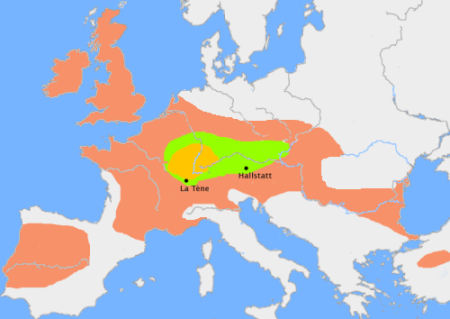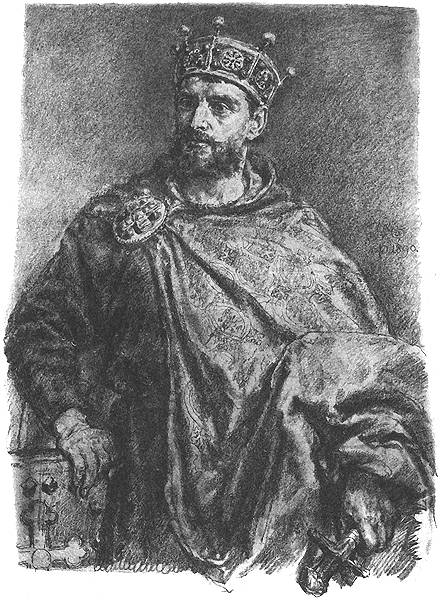Eurola
Thanks Eurola
Few quotations:
Early Slavic Origins
ancientweb.org/Poland/index.htm
in between these peoples were the ancient aboriginal Slavs
Archeology has not as yet determined the western most boundaries of Slavdom. The primitive custom of the Slavs of burning their dead, which lasted throughout the Stone Age and well into the Bronze
The westernmost outposts of the Slavs were very early annihilated by the Teutons, who pushed the Slavs toward the east. This early German "Drangnach Osten" was halted by the Slavic tribes living along the Warthe*, Oder** and Netze*** Rivers, called Poloni by, the early Latin chronicles.
From link that you presented to us we nicely see conclusion of author (no matter all controverses) that Slavs represented native population of Europe and that they very early were target for conquests of hostile neighbors.
Paleolithic Continuity Theory proposed by today already well known Italian historian Mario Alinei, strongly support obvious fact that Slavs were positioned in Europe since time immemorial, in deep past of Europe and much before BC.
PCT
continuitas.com/
continuitas.com/intro.html
(e) The totally absurd thesis of the so called 'late arrival' of the Slavs in Europe must be replaced by the scenario of Slavic continuity from Paleolithic, and the demographic growth and geographic expansion of the Slavs can be explained, much more realistically, by the extraordinary success, continuity and stability of the Neolithic cultures of South-Eastern Europe (the only ones in Europe that caused the formation of tells) (Alinei 2000, fc.b)
Moving west from central Asia, they settled in eastern and southeastern Europe during the 2nd and 3rd millennia BC.
Hire we must be careful
Why?
We must be aware that Slavs were ethnic formation stretched on intercontinental level from deep past and we often speak just about inter-Slavic migrations (newest scientific results suggest that there was no so called great/massive migration in time BC) and not about some cataclysmically penetration on foreigners. Hostile foreigners who penetrated into Slavic world regularly come from direction of west or south. Just later, with arrival of Huns and Mongols, eastern borders of Slavdom were endangered.
It's not questionable that Europe was populated by humans after Near East or Asia was already populated. Only real questions are: precise dating of moment when Europe was populated, who was first and under which conditions Europe was populated (by conquest or in peaceful process). All these questions are under political supervision, for obvious reasons.
See this (also, in connection with Biskupin in Poland)...
The earliest signs of human activity in the basins of the Vistula and Oder date back to about 100 thousand BC. Neanderthal hunters crossed the area, especially present-day southern Poland. The earliest settlements of Homo Sapiens in Poland go back to the Mesolithic Age (8 thousand - 5.5 thousand BC).These settlements were established by migrant peoples belonging to the Danubian Basin Culture.
...the earliest traces of the "Amber Road
Source:
Proto-Slavonic origins
poland.gov.pl/History,319.html
This article also operates with possibility that newcomers from Asia penetrated in Europe and combined with native population.
You know what Slavic autochtonistic theory suggest in case with this (on the base of all that I already sow on topic, I absolutely agree)?
Proto Slavs very early were positioned from Europe, via Eurasia to Asia and Near East. On their historic path they were separated due to constant immigration after Ice Age was finished and, then our ancestors combined in that what would become embryo of modern Slavs. That's how Sarmatians were born.
Now, focus your attention on few maps...
Map of Aryan migration
Philologists can also, moreover, safely conclude that the Aryans must have had kings prior to emigrating from their original homeland in southern Russia.
indhistory.com/aryan.html
Maps of Celtic distribution thru Europe

The green area suggests a possible extent of (proto-)Celtic influence around 1000 BC. The yellow area shows the region of birth of the La Tène style. The orange area indicates an idea of the possible region of Celtic influence around 400 BC.

The Celts in Europe, past and present
Celtic languages were once predominant over much of Europe, with territory largely ceded to expanding Germanic tribes and the invading Roman Empire. Archaeological and historical sources show that at their maximum extent in the third century BC, Celtic peoples were also present in areas of Eastern Europe and Asia Minor.[2]
en.wikipedia.org/wiki/Celt
Galatia, an ancient region of Asia Minor, was named for the immigrant Gauls from Thrace (cf. Tylis), who settled here and became its ruling caste in the 3rd century BC. It has been called the "Gallia" of the East, Roman writers calling its inhabitants Galli.
en.wikipedia.org/wiki/Galatia
I also recommend this for reading...
Celtic tribescelticgrounds.com/chapters/appendix/celtic_tribes.htm
This is how journey began
Now guess what's the missed link of this story?
Missed link of this story is Danubian culture with all cultures which developed from her and around her. From Balkan along the Danube River and Black See, thru Panonia, to the Adriatic coast and to the Baltic see.
The term Danubian culture was coined by the Australian archaeologist Vere Gordon Childe to describe the first agrarian society in central and eastern Europe. It covers the Linear Pottery culture (Linearbandkeramik, LBK), stroked pottery and Rössen cultures.
The beginning of the Linear Pottery culture dates to around 5500 BC.
Danubian I peoples cleared forests and cultivated fertile loess soils from the Balkans to the Low Countries and the Paris Basin.
This is the moment when second branch of Proto Slavs reached first branch and combined with her...
A second wave of the culture, which used painted pottery with Asiatic influences, superseded the first phase starting around 4500 BC. This was followed by a third wave which used stroke-ornamented ware.
Danubian sites include those at Bylany in Bohemia and Köln-Lindenthal in Germany
en.wikipedia.org/wiki/Danubian_culture
If we follow Danubian culture we can learn about interesting things about people who created that culture and from where they come, how thgey live and how they spred with use of agriculture.
Lusatian cultureen.wikipedia.org/wiki/Lusatian_culture

A simplified map of the central European cultures, ca 1200 BC. The purple area is the Lusatian culture, the central blue area is the Knoviz culture, the red area is the central urnfield culture, and the orange area is the northern urnfield culture. The brown area is the Danubian culture, the blue area is the Terramare culture and the green area is the West European Bronze Age. The yellow area is the Nordic Bronze Age
The Lusatian culture existed in the later Bronze Age and early Iron Age (1300 BC-500 BC) in eastern Germany, most of Poland, parts of Czech Republic and Slovakia and parts of Ukraine.
Numerous Czech (Píć, Niederle, Ćervinka) and Polish (Majewski, Kostrzewski, Kozłowski) authors believed the Lusatians to be Proto-Slavs
Corded Ware cultureen.wikipedia.org/wiki/Corded_Ware
It encompassed most of continental northern Europe from the Rhine River on the west, to the Volga River in the east, including most of modern-day Germany, Denmark, Poland, Lithuania, Latvia, Estonia, Belarus, the Czech Republic, Slovakia, northern Ukraine, western Russia, as well as coastal Norway and the southern portions of Sweden and Finland.
The Corded Ware people are mostly seen as ancestral to Proto-Balto-Slavicin its eastern regions,and to the Centum dialects (i.e. Proto-Germanic, Proto-Celtic and Proto-Italic) in the western parts.
For good night, one article
DID ODIN EXIST?by Sergei V. Rjabchikov
T. Heyerdahl and P. Lillieström (2001) believe that the Scandinavian god Odin was indeed a Proto-Slavonic king who lived near the Sea of Azov (now it is the Rostov-on-Don region, Russia) in 100 - 200 A.D. Then this king was forced out by the Romans from the area of the Don river and settled down in Scandinavia. This hypothesis is based on the data obtained during the excavations of the Russian-Norwegian archaeological expedition under the leadership of T. Heyerdahl at the town Azov, the Rostov-on-Don region, Russia, in 2001.
a Bosporan name, Ardinzianos (Ardinzian), consists of Scythian/Sarmatian ar 'Aryan', din 'day' and zian 'shine; light; radiance; the sun'; this name signifies 'An Aryan (by name) 'The daylight''. So the Proto-Slavonic name Din 'Day' (cf. the name Odin) might be spread among the Scythians and Sarmatians.
Afterwards this ruler and his warriors were forced out by the Roman and Bosporan troops from the area of the Don river, and then this group of the Proto-Slavs migrated to Scandinavia.
 PolishForums LIVE / Archives [3]
PolishForums LIVE / Archives [3]













